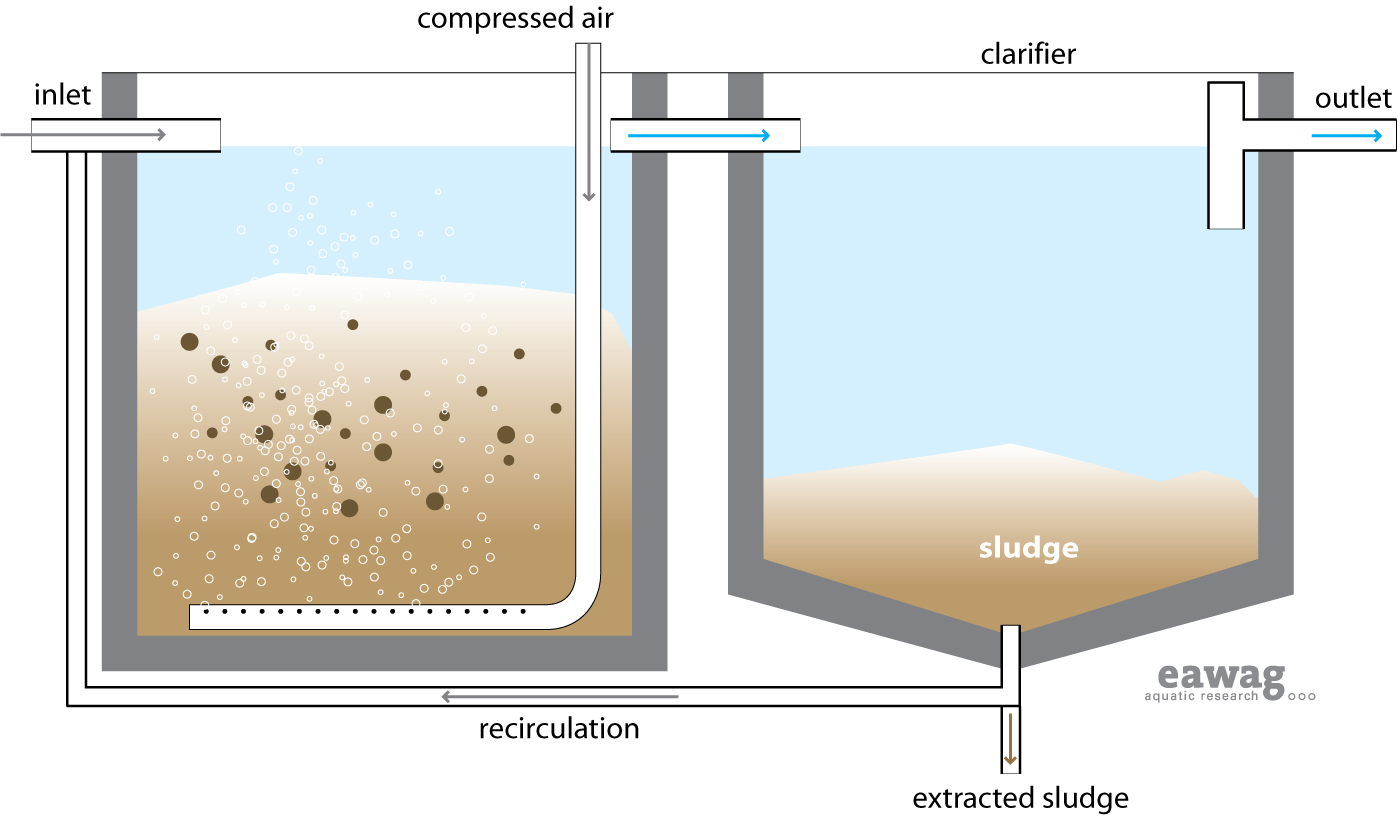Activated Sludge
|
|||||||||||||||||||||||||||
Activated Sludge is a multi-chamber reactor unit that makes use of (mostly) aerobic microorganisms to degrade organics in wastewater and to produce a high-quality effluent. To maintain aerobic conditions and to the keep the active biomass suspended, a constant and well-timed supply of oxygen is required.
Different configurations of the Activated Sludge process can be employed to ensure that the wastewater is mixed and aerated (with either air or pure oxygen) in an aeration tank. The microorganisms oxidize the organic carbon in the wastewater to produce new cells, carbon dioxide and water. Although aerobic bacteria are the most common organisms, aerobic, anaerobic, and/or nitrifying bacteria along with higher organisms can be present. The exact composition depends on the reactor design, environment, and wastewater characteristics. During aeration and mixing, the bacteria form small clusters, or flocs. When the aeration stops, the mixture is transferred to a secondary clarifier where the flocs are allowed to settle out and the effluent moves on for further treatment or discharge. The sludge is then recycled back to the aeration tank, where the process is repeated.
To achieve specific effluent goals for BOD, nitrogen and phosphorus, different adaptations and modifications have been made to the basic Activated Sludge design. Aerobic conditions, nutrient-specific organisms (especially for phosphorus), recycle design and carbon dosing, among others, have successfully allowed Activated Sludge processes to achieve high treatment efficiencies.
| Advantages | Disadvantages/limitations |
|---|---|
| - Good resistance against shock loading. - Can be operated at a range of organic and hydraulic loading rates. High reduction of BOD and pathogens (up to 99%). - Can be modified to meet specific discharge limits. |
- Prone to complicated chemical and microbiological problems. - Effluent might require further treatment/ disinfection before discharge. - Not all parts and materials may be available locally. - Requires expert design and supervision. - High Capital cost; high operation cost. - Constant source of electricity is required. - Effluent and sludge require secondary treatment and/or appropriate discharge. |
Contents
Adequacy
Activated Sludge is only appropriate for a centralized treatment facility with a well-trained staff, constant electricity and a highly developed centralized management system to ensure that the facility is operated and maintained correctly.
Activated Sludge processes are one part of a complex treatment system. They are used following primary treatment (that removes settleable solids) and before a final polishing step. The biological processes that occur are effective at removing soluble, colloidal and particulate organic materials for biological nitrification and denitrification and for biological phosphorus removal. This technology is effective for the treatment of large volumes of flows: 10,000 to 1,000,000 people.
Highly trained staff is required for maintenance and trouble-shooting. The design must be based on an accurate estimation of the wastewater composition and volume.
Treatment efficiency can be severely compromised if the plant is under- or over- designed. An Activated Sludge process is appropriate for almost every climate.
Health Aspects/Acceptance
Because of space requirements, Centralized treatment facilities are generally located away from the densely populated areas that they serve. Although the effluent produced is of high quality, it still poses a health risk and should not be handled directly.
Maintenance
The mechanical equipment (mixers, aerators and pumps) must be maintained constantly. As well, the influent and effluent must be monitored constantly to ensure that there are no abnormalities that could kill the active biomass and to ensure that detrimental organisms have not developed that could impair the process (e.g. filamentous bacteria).
References
- Crites, R. and Tchobanoglous, G. (1998). Small and Decentralized Wastewater Management Systems. WCB and McGraw-Hill, New York, USA. pp 451–504. Comprehensive summary including solved problems.
- Ludwig, HF. and Mohit, K. (2000). Appropriate technology for municipal sewerage/Excreta management in developing countries, Thailand case study. The Environmentalist 20(3): 215–219. (Assessment of the appropriateness of Activated Sludge for Thailand.)
- von Sperling, M. and de Lemos Chernicharo, CA. (2005). Biological Wastewater Treatment in Warm Climate Regions, Volume Two. IWA, London.
- Tchobanoglous, G., Burton, FL. and Stensel, HD. (2003). Wastewater Engineering: Treatment and Reuse, 4th Edition. Metcalf & Eddy, New York.
Acknowledgements
The material on this page was adapted from:
Elizabeth Tilley, Lukas Ulrich, Christoph Lüthi, Philippe Reymond and Christian Zurbrügg (2014). Compendium of Sanitation Systems and Technologies, published by Sandec, the Department of Water and Sanitation in Developing Countries of Eawag, the Swiss Federal Institute of Aquatic Science and Technology, Dübendorf, Switzerland.
The 2nd edition publication is available in English. French and Spanish are yet to come.

